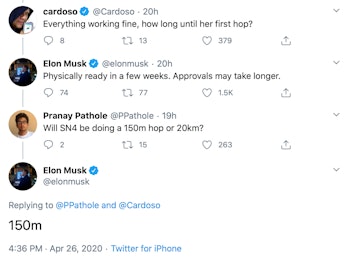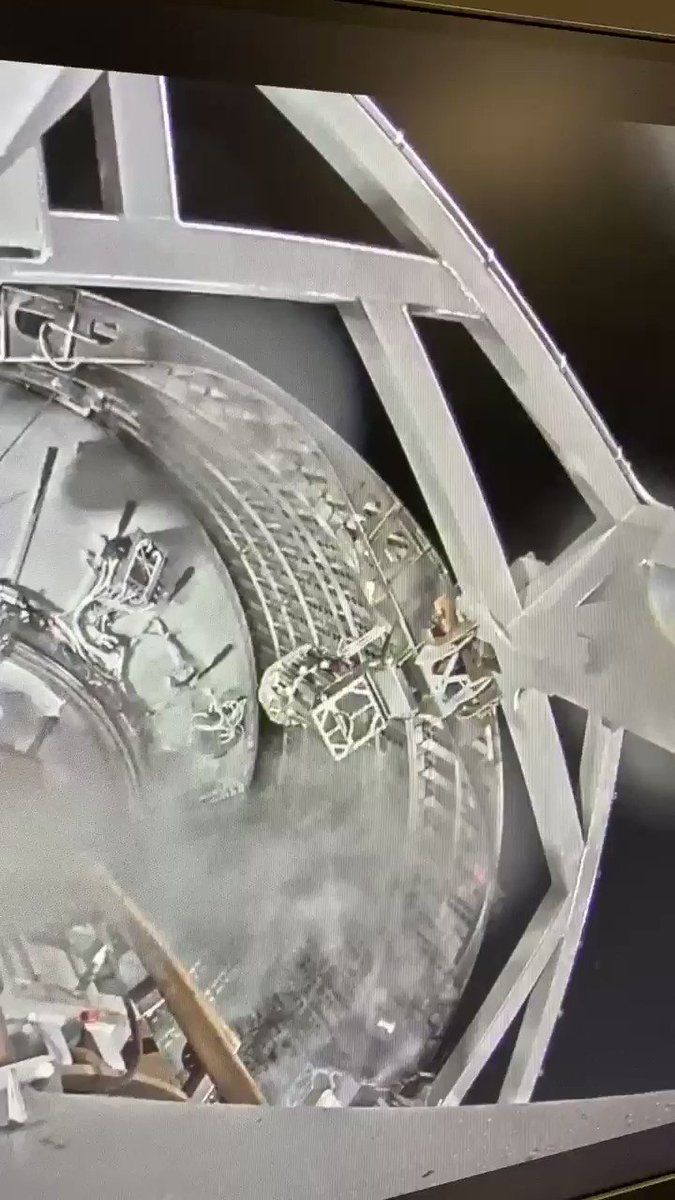Read The Full Article On: Inverse
The Starship, SpaceX’s ambitious under-development rocket, is about to fly for the first time.
The space-faring firm has been building prototype models of the rocket, designed to send humans to Mars and beyond, at the Boca Chica facility in Texas. CEO Elon Musk declared on Twitter Sunday that one of these prototype models, dubbed “SN4,” would be the first to launch as part of a “hop test.”
It’s a major step forward for the project, which has been working on a collection of these rockets in preparation for a full-scale orbital test flight. Musk also confirmed that this milestone flight could be ready to go in the next few weeks:
Physically ready in a few weeks. Approvals may take longer.

A static fire of “SN4″‘s single Raptor engine, which will double-check the engine ahead of the launch, is expected to occur this week.
The Starship is designed to send over 100 tons or 100 people into space, with a fully-reusable design and liquid oxygen and methane fuel. These features mean a team can fly to Mars, refuel using the planet’s resources, then return home. That, in turn, paves the way for some of SpaceX’s more ambitious goals, like a city on Mars by 2050 and farther-flung ventures that turn humanity into a multi-planetary species.
Preparations took another step closer on Sunday after the SN4 prototype passed an ambient pressure test. It also passed a proof test at ultra-cold cryogenic temperatures, reaching 4.9 bar. That’s not quite the same levels of pressure as achieved with a smaller test tank in January 2020, but Musk claimed it’s “enough to fly.”
The Starship prototype is expected to hop 150 meters, or nearly 500 feet, into the air. That may represent one small hop for SN4, but it could represent one giant leap for the Starship line.Elon Musk✔@elonmusk
Snowing in Texas

SPACEX STARSHIP: BUILDING THE SHIP OF THE FUTURE
When Musk outlined his plans for Starship in September 2017, it was still dubbed BFR. He explained that the ship would be designed to take over duties for all the firm’s other rockets, making it a more economical project. That means Falcon 9 and Falcon Heavy, currently used for sending up satellites and other cargo but also soon expected to launch humans next month with the Crew Dragon project.
The ship may have changed name, material and design, but it’s still expected to perform this basic duty. In July 2019, a SpaceX representative revealed that the first Starship missioncould be a telecommunications satellite in 2021. That means the clock is ticking for SpaceX to complete a test flight with its rocket and pave the way for its first commercial mission.
In August 2019, a miniaturized version of Starship called “Starhopper” made a breakthrough. The ship, described by Musk as “R2D2’s dad,” flew 150 meters into the air on a sunny day in Texas. The ship has only one Raptor engine, though, where the Starship is expected to pack six. The Super Heavy booster that will pair with the Starship and help it leave Earth could pack up to 37 more engines.
The Starhopper also differed on height. It had the same 30-foot diameter as its bigger brother, but measured just 30 feet. The first full-size Starship prototype, “Mk.1” unveiled in September 2019, measured 164 feet high. Paired with the Super Heavy booster, the whole construction measured nearly 400 feet. Musk has since declared that the design is “evolving rapidly,” meaning these figures are being tweaked regularly.
At the September 2019 event, Musk declared that the first orbital flight could take place around six months from then. That placed the launch window some time around March 2020. But the project has seen a number of prototypes fail under pressure tests. “Mk.1″‘s top blew off in November 2019, an “SN1” prototype suddenly jumped into the air in January 2020, and “SN3” crumpled in April 2020.
Local government documents suggested that SpaceX was planning to fly “SN3” in a hop test. Although that plan appeared to buckle under pressure, it seems “SN4” will be the first Starship prototype to fly on purpose.
THE INVERSE ANALYSIS
The success of “SN4″‘s pressure tests seem to have given SpaceX confidence that it’s ready to fly, but there’s still work to be done.
The full-size prototype achieved a pressure of 4.9 bar. Around one bar is the level of atmospheric pressure at sea level. Musk claimed in January 2020 that six bar is needed for an orbital flight, and around 8.5 bar is needed for human spaceflight. SpaceX achieved these levels with a small test tank that month, but it seems “SN4” has not met the same levels.
Musk acknowledged the low figure for “SN4” on Sunday as “kind of a softball tbh,” but also declared “that’s enough to fly.” A short flight for the full-size ship will be a key step forward, but there’s plenty of work to go before SpaceX can start sending astronauts to Mars.

